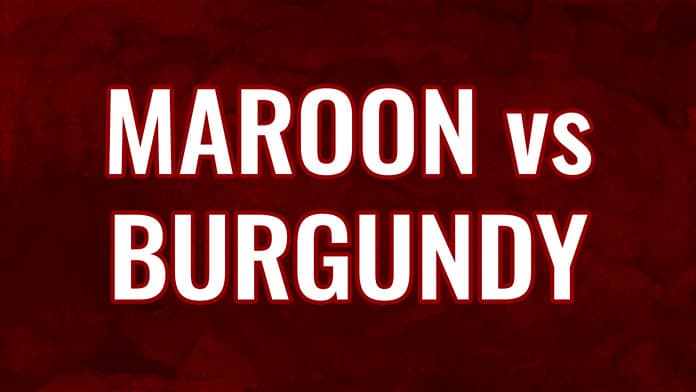
Recognizing the differences between maroon vs burgundy isn’t always easy.
Both colors consist primarily of a red base, and the distinctions between them can often be quite subtle.
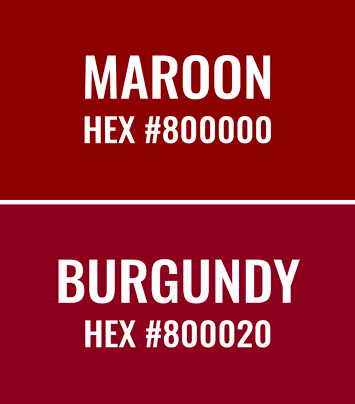
In fact, even some dictionaries actually disagree about the definitions, which adds to the confusion and makes it even harder to understand the difference.
Plus, a lot of people don’t even realize that burgundy and maroon are different colors, and mistakenly use the two terms interchangeably.
And that’s a shame, because learning to recognize the unique traits of each color is the best way to use them effectively for fashion, interior design, graphic design or anything else.
In this post we’ll cut through the confusion and break down the key characteristics of both burgundy and maroon so you can learn how to use both to great effect.

Burgundy vs Maroon
What’s the difference between burgundy and maroon? Well…

Burgundy Color
What color is burgundy?
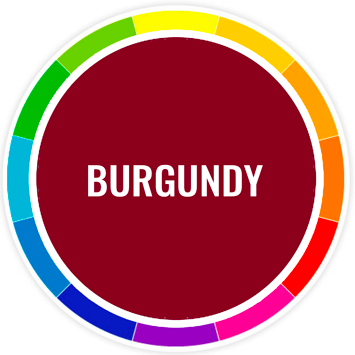
Burgundy is a deep red color with a distinctly purplish tinge that derives its name from the Burgundy region of France.
Well, to be more specific, the name actually comes from the region’s famous Burgundy wine, which is made from the red pinot noir grape and bears the deep purplish-red color now simply known as burgundy.
Is burgundy red?
Yes, burgundy is definitely in the red family.
As mentioned, the name burgundy derives from the red wine color, and while it does have some purple present within it, it primarily uses a red base.
Is burgundy purple?
Only a little. Burgundy has purple undertones, but it’s primarily a red color.
On the sRGB (standard Red, Green and Blue) color scale, which HP and Microsoft created in the ‘90s to display colors on monitors, burgundy has a red score of red 128, green 0 and blue 32.
The presence of some blue mixed with a high degree of red is what gives burgundy its purple hue, but it’s not the most prominent element of the color.
Is burgundy a natural hair color?
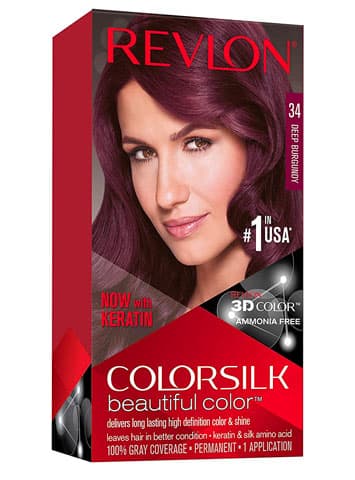
No, burgundy is not a natural hair color. Maroon is probably more likely to occur as a natural color since (as we’ll explain below) it has more of a brownish tinge.
Burgundy, on the other hand, is more of a purplish red, and purple isn’t a naturally occurring hair color.
But with that said, vivid burgundy has become a popular color for hair dye.
In particular, dark burgundy has become a popular winter color for those who prefer to sport a darker shade during the colder months.
Burgundy Complementary Colors
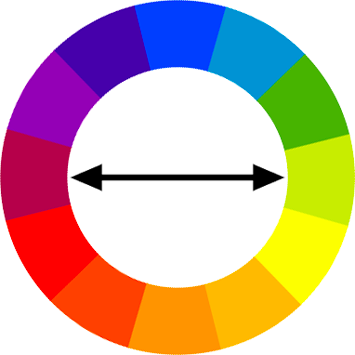
There are a number of different colors that work well with burgundy.
Generally speaking, a particular color’s complementary counterparts are found on the opposite end of the color wheel.
Since burgundy is a red color with purple tones, its most complementary colors are in the yellow-green family, which sit directly opposite on the wheel.
But in both fashion and interior design, burgundy offers a lot more possibilities for color combination.
In color psychology, the color of burgundy is associated with sophistication. So it works really well with other dark colors that have a similar air of refinement, like navy blue.
Additionally, the rich hue of burgundy pairs well with a neutral color like gray, or even lighter, almost white colors.
A lot of people opt to wear burgundy during the winter season, when the warmer burgundy shades can help brighten an otherwise dark wardrobe while still feeling seasonally appropriate.
Maroon Color
What color is maroon?
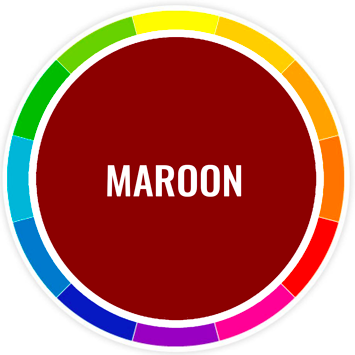
The color maroon is generally considered to be a shade of red with a certain amount of brown in it, although how much brown is open to interpretation.
In the Oxford English Dictionary, maroon is described as “a brownish crimson (strong red) or claret (purple color) color.”
Meanwhile, Dictionary.com says maroon is a dark brownish-red, and Merriam Webster simply says it’s dark red, and doesn’t mention anything about brown color.
So the exact definition of maroon varies more than the definition of burgundy, which is closely tied to the color of the wine.
Is maroon red?
Yes, maroon is a distinctive red shade of color. But whereas the color burgundy has a red base with shades of purple, maroon most often describes a range of reddish brown shades.
Is maroon purple?
Not really, which is the key difference between maroon and burgundy. There is one dictionary, the Cambridge English Dictionary (Oxford’s rival), which describes the word maroon as “a dark reddish-purple color.”
But even then, the American version of the Cambridge defines it as a “dark brown-red,” without mentioning purple at all.
Where does the name maroon come from?
In the English language, the color name maroon is derived from the French word marron, which means chestnut, or a shade of brown.
Is Maroon 5 a good band?
I don’t really see how that’s relevant here, but no.
They are, objectively, not a good band.
Maroon Complementary Colors
Maroon falls very closely to burgundy on the color wheel, so a lot of the same colors that complement burgundy also work well with maroon.
But since maroon is a little more brown than purple, it pairs even better with shades of blue, since the blue-and-brown combo is a classic color pairing.
Shades of Maroon
One reason that the definition of maroon is less well defined than burgundy is because the amount of brown color in maroon can vary, resulting in a number of different shades.
The range of maroon colors can include everything from lighter shades, like a bright maroon color with a positive and light energy, to a foreboding and dark maroon that almost looks like a mix of red and black, not red and brown.
Here are a few popular shades of maroon (along with the corresponding hexadecimal code for each) that will give you an idea of how much variance there can be between the various shades:
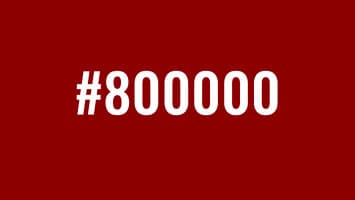
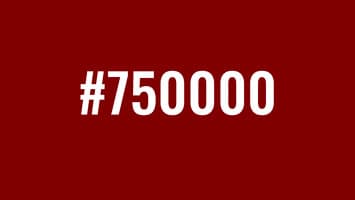
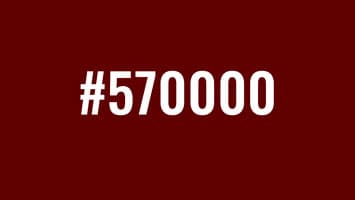
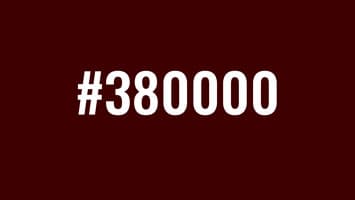
Burgundy and Maroon Comparisons
Maroon vs Burgundy: Which is darker?
It depends. As mentioned above, maroon can admit of multiple different shades, some of which can resemble really rich and dark reds.
In the hexadecimal notation system used to denote colors online, here are the basic color codes for both burgundy and maroon, which were also featured above:
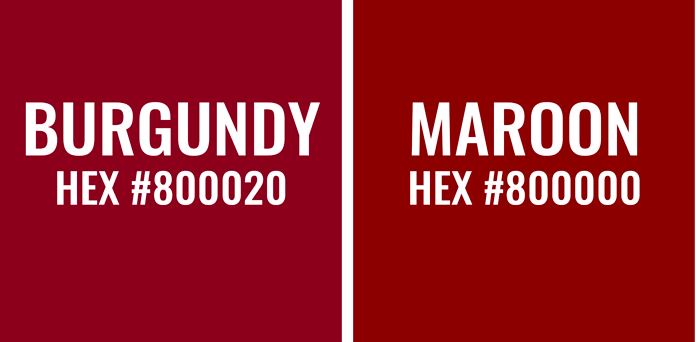
As you can see, they’re quite close both in numeric value, and just in terms of how they appear to the eye.
But as the shades of maroon listed above demonstrate, there can be huge variance with maroon, even though they all use a red undertone as their starting point.
Burgundy vs Maroon Hair Color

As mentioned, burgundy is not a naturally occurring hair color, but some people with a particularly reddish tone of brown hair could describe their color as maroon.
In terms of hair dye, the phrases deep burgundy and deep maroon are often used interchangeably, and tend to describe the same color.
It’s understandable why the distinction between the two is less clear with hair dye, since your hair color doesn’t have to be all or nothing.
For instance, when someone with black hair gets burgundy highlights, the result is a dark hair color that can often look more like a particularly dark shade of maroon than a pure burgundy.
Mahogany vs Burgundy Hair Color
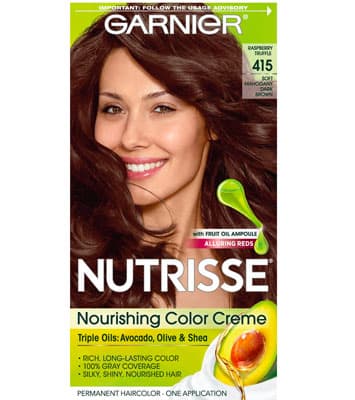
With mahogany hair dye there’s a little more distinction from burgundy.
As the name implies, mahogany has more of a woody, brown undertone than burgundy, which is a purplish red.
So the bad news is that if you’re looking for maroon hair dye, you might be out of luck.
But the good news is that if you fear burgundy dye might be too purple, you have another option.
It might be a good idea to try mahogany, which should get closer to your desired effect.
Maroon vs Burgundy vs Red
As mentioned above, red is the base color of both maroon and burgundy. But the two are distinguished by the additional hues that are added to red: Maroon has brown undertones, while Burgundy has a distinctly purple hue.
Burgundy vs Maroon vs Wine
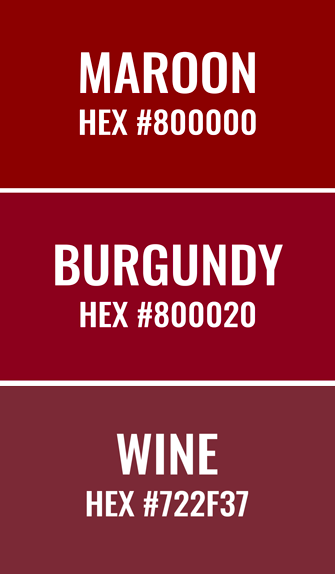
While burgundy is named for the color of the wine that comes from the region, there’s another color, simply called wine, which is similar to both burgundy and maroon.
Where Burgundy vineyards chiefly grow the pinot noir grape, which leads to wine with a distinct color, there are dozens of other grape varietals used to make wine all over the world.
The color called wine reflects some of these other varietals, and is sometimes also called “bordeaux,” which is another popular winemaking region of France that’s best known for blending different grapes into the same wine, resulting in a range of different colors.
Burgundy vs Maroon vs Plum
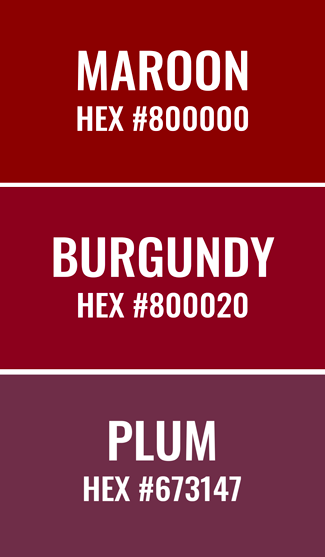
Plus is also sometimes confused for burgundy and maroon, but has one big difference that sets it apart from both:
Plum uses purple as a base color.
From there, different shades of plum can vary, depending on whether they have hues of brown and gray or hues of red.
So in some ways plum is kind of like the reverse of maroon and burgundy.
Whereas those two colors both use red as a base and then differ in the amount of brown or purple that’s mixed in, plum uses purple as a base, and then its various shades differ based on how much brown or red is mixed in.
More Color, Style & Grooming Advice from Irreverent Gent:
- Teal vs Turquoise: All the Key Differences, Explained
- The Most Attractive Men’s Dress Shirt Colors
- The (Absolute) Best Athletic Fit Dress Shirts for Muscular Guys
- The Best Men’s Pants Colors
- How to Rock a Blue Suit with Brown Shoes
- The 17 Best Beard Straightening Brushes
- The Best (Other) Jewelry Brands Like Tiffany & Co
